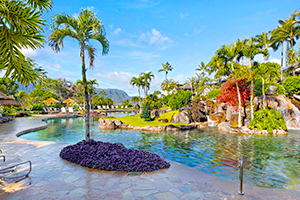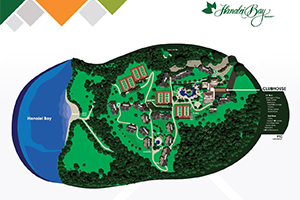Kauai is home to some of the most amazing and beautiful sights, including the Kilauea Lighthouse and Wildlife Refuge. Kilauea Point National Wildlife Refuge (Point NWR) was established in 1985 to protect and enhance migratory seabirds and threatened and endangered species and their habitats. The focus of the refuge is to expand and enhance existing habitats for those species they are protecting. Learn more about this refuge and all the amazing animals and sights to be seen!
The refuge is home to thousands of migratory and resident birds including: mōlī (Laysan albatross), ‘ā (red footed booby), koa‘e ‘ula (red-tailed tropicbird), koa‘e kea (white-tailed tropicbird), ‘iwa (great frigatebirds), ‘ua‘u kani (wedge-tailed shearwaters), kōlea (Pacific golden plover), nēnē (Hawaiian goose, threatened), ‘a‘o (Newell’s shearwater, threatened), and pueo (Hawaiian short-eared owl). You can also spot humpback whales, green sea turtles, spinner dolphins, and Hawaiian monk seals from the Humpback Whale Marine Sanctuary just offshore. The refuge supports one of the largest populations of nesting seabirds in Hawai‘i.
The refuge is also home to the historic Kīlauea Point Light Station. The lighthouse sits on the northernmost point of Kauai and for 62 years the light guided ships safely along Kauai’s north shore. The Kīlauea Point Light Station is a significant historical site, featuring a notable lighthouse and Fresnel lens.
For more information regarding visiting hours, the refuge is open Wednesday through Saturday from 10am to 4pm. The full schedule of hours and events is available on the refuge’s website. Visitors must arrive before 3:30pm and the refuge is closed on major federal holidays, such as Thanksgiving, Christmas, and New Year’s Day, as well as the Saturday before these holidays. Reservations are required for all adults 16 and older, check out their website here to make a reservation. Upon arrival entry, visitors must buy a pass at the entrance, bring cash and a photo id for the transaction.
Passes and entry options include the ability to buy pass at the entrance, where beautiful passes such as the America the Beautiful pass, golden age pass for seniors, and other federal passes are accepted. These beautiful passes not only grant access but also symbolize entry to the refuge’s stunning landscapes and wildlife. Pass holder entry is available, and a pass holder can select the interagency pass holder entry option during booking; pass holders must be present for entry. Passes admit the pass holder and up to three additional adults. Interagency pass holder entry is a dedicated option for those with qualifying passes. Kamaʻāina pass is available for Hawaiʻi residents with a valid state id, providing special access and discounts. Hawaiʻi residents can also purchase site-specific annual passes with a valid state id. A valid state id is required for Hawaiʻi residents to access these discounts or passes. Military personnel may use a military id for entry or discounts. A photo id is required for all pass purchases and to verify eligibility for discounts. Mobile users can make reservations or buy passes via their mobile devices.
The parking lot is conveniently located near the entrance, with a paved path leading to the visitor center. Visitors needing assistance can use the golf cart service from the parking lot to the visitor center.
Access to the refuge is via Kīlauea Road, which serves as the main route to the entrance.
Be sure to add this adventure to your itinerary and book your stay at Hanalei Bay Resort today!
Introduction to Kīlauea Point National Wildlife Refuge
Perched on the northern most point of the main Hawaiian Islands, Kīlauea Point National Wildlife Refuge is a sanctuary for some of Hawai‘i’s most remarkable wildlife. This point national wildlife refuge is uniquely situated atop a dramatic 180-foot bluff, part of the former Kīlauea volcanic vent, offering visitors spectacular views of the Pacific Ocean and the lush coastline. As a vital part of the national wildlife refuge system, Kīlauea Point National Wildlife Refuge provides critical habitat for migratory seabirds, endangered species like the Hawaiian goose (nēnē), and native Hawaiian coastal plants. The refuge is also a haven for green sea turtles and Hawaiian monk seals, making it a must-visit destination for anyone interested in the natural wonders of the Hawaiian Islands. Whether you’re a wildlife enthusiast or simply seeking breathtaking scenery, Kīlauea Point is a place where the beauty and diversity of the main Hawaiian Islands truly come alive.
The Inouye Kīlauea Point Lighthouse
Standing as a beacon on the rugged coastline, the Daniel K. Inouye Kīlauea Point Lighthouse is a treasured landmark within the refuge. Built in 1913, this historic lighthouse is listed on the National Register of Historic Places and is renowned for its 2nd-order Fresnel lens, which once guided mariners safely along the north shore. The inouye kīlauea point lighthouse played a key role in the first trans-Pacific flight from the West Coast to Hawai‘i, marking a pivotal moment in aviation and natural history. Today, visitors can explore the lighthouse grounds, learn about its storied past, and take in panoramic views of Kīlauea Point and the surrounding refuge. The lighthouse remains a symbol of the region’s rich heritage and continues to draw visitors eager to experience a piece of Hawai‘i’s history.
Exploring Kīlauea Point
A visit to Kīlauea Point National Wildlife Refuge offers a wealth of experiences for nature lovers and adventure seekers alike. The refuge is a premier spot for whale watching, especially during the winter months when humpback whales migrate through Hawaiian waters. Birdwatchers will delight in observing thousands of nesting seabirds, including red-footed boobies, laysan albatross, and great frigatebirds, all thriving within this protected wildlife refuge. The journey to the point is an easy five-minute walk along a paved path with a slight uphill grade, making it accessible for most visitors. For those needing assistance, a golf cart is available at the fee booth to ensure everyone can enjoy the stunning vistas. The visitor center at Kīlauea Point National Wildlife Refuge provides fascinating insights into the area’s natural history, refuge operations, and ongoing conservation efforts, making your visit both educational and memorable.
The Point National Wildlife Refuge
As a proud member of the Point National Wildlife Refuge system, Kīlauea Point National Wildlife Refuge is dedicated to safeguarding the unique wildlife and habitats of Hawai‘i. In partnership with the U.S. Fish and Wildlife Service and other organizations, the refuge implements vital conservation initiatives to protect endangered species and restore native ecosystems. One notable project is the Nihokū Ecosystem Restoration Project, which creates a safe, predator-free nesting area for vulnerable seabirds like Newell’s shearwaters and Hawaiian petrels. Visitors can support these important efforts by purchasing an America the Beautiful pass or a Federal Duck Stamp—both of which help fund conservation work across national wildlife refuges. Every pass purchased contributes directly to the protection of the refuge’s diverse fish, wildlife, and plant species, ensuring that Kīlauea Point remains a sanctuary for generations to come.
Wildlife Refuge Conservation Efforts
Conservation is at the heart of everything at Kīlauea Point National Wildlife Refuge. The refuge’s dedicated team works tirelessly to preserve native Hawaiian coastal plants, protect endangered species, and maintain the delicate balance of the local ecosystem. Visitors play a vital role in these efforts by following refuge guidelines, such as staying on marked trails and avoiding disturbance of sensitive wildlife. Educational programs, including keiki field trips, are offered to foster a deeper appreciation for the refuge’s unique natural resources and the importance of conservation. By respecting the rules and participating in these activities, visitors help protect the incredible wildlife and habitats of Kīlauea Point National Wildlife Refuge, ensuring that this special place continues to thrive for future generations.





